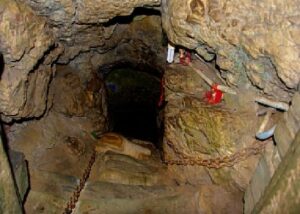
Patal Bhuvaneshwar is a limestone cave temple 14 km from Gangolihat in the Pithoragarh district of Uttarakhand state in India.
Patal Bhuvaneshwar cave temple is at a height of 1350 meters above sea level. It is said that the darshan at Patal Bhuvaneshwar yields a thousand times the fruit of tapasya at Kashi, Baidyanath or Kedarnath. In the Skanda Purana, Manas Kanda, Chapter 103, there is a description of the blessings to be attained in visiting Patal Bhuvaneshwar.
Patal Bhuvaneshwar is not just one cave, rather a cave city. The cave is 160 m long and 90 feet deep from the point of entrance. Limestone rock formations have created various spectacular stalactite and stalagmite figures of various hues and forms. This cave has a narrow tunnel-like opening which leads to a number of caves. The cave is fully illuminated electrically. It is built due to the flow of water. The water has cut the rocks in such a fascinating way that it looks like that some artist had made those entire statues within the cave & on its wall. It has some cave opening and it is believed that these opening will close as the centuries pass on. The scientific fact is it still being developed due to crystallization of the minerals which are dissolved in the water.
One has to descend nearly 100 steps into this narrow cave, to reach the sanctum sanctorum, which gives an overwhelming feeling that you’re entering the centre of the earth. Each stone, each stalagmite within each cave or doorway, in magnificent erection revels the story of Hindu pantheon in the shapes of Gods, Goddesses, saints and known mythological characters.
Mythology of Patal Bhuvaneshwar :-
Legend and folklore have it that this underground cave enshrines Lord Shiva and thirty three crore (330 million) Gods. According to belief King Rituparna of the Sun dynasty (Surya Vansha) discovered the cave in ‘Treta yug’. It is also believed that this cave is internally connected to the four abodes / seats (Char Dham).
Adi Shankaracharya visited this cave in 1191 AD. That was the beginning of the modern pilgrimage history, at Patal Bhuvaneshwar. The journey inside the cave has to be carried in feeble lights, holding protective iron chains. The Stone formations of Sheshnag can be seen, holding earth, heaven the world beneath. ‘Havan’ (fire sacrifice) is performed in a dimly lit, solemn atmosphere, under the spell of holy chants. One can also be impressed by the huge stalactites, called “jatas” of Lord Shiva, located at different location inside the cave. This is where Shiva rested when he chose to visit these parts from the celestial heights of His abode in Kailash.
The cave, it is believed, is connected by an underground route to Mount Kailash. It is believed that Pandavas, the ‘Mahabharat’ heroes proceeded towards their last journey in the Himalayas after meditating here, in front of Lord Shiva.
Source:
http://www.nainitaltourism.com/Patal_Bhuvaneshwar.html


